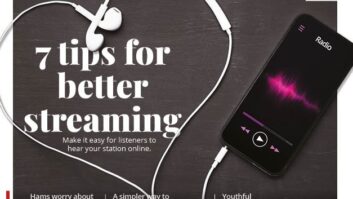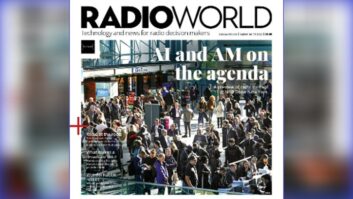… One Format at a Time
Correspondence from a colleague (June 21, page 54) took issue with one of my columns (“Broadcasters, Pick Your Poison,” April 20).
The reader – Ira Wilner, CE at Monadnock Radio Group, Keene, N.H. – felt compelled to point out that Webcasting was a costly option for both broadcasters and listeners, arguing that over-the-air (OTA) broadcasting was “the only effective way to reach a truly large audience at minimal cost.” He agreed with the column’s point that radio broadcasters should participate in popular alternative media, but felt that they should not lose sight of their “primary business, OTA radio, ” and thus he was “a strong champion of HD Radio multicasting.”
Of course, I agree with Ira’s premise regarding the undeniable cost-effectiveness of OTA broadcasting, and that it’s still broadcasters’ primary business. I hope that nothing in that column would lead anyone to believe otherwise. Let me take this opportunity to clarify that these points are unquestioned – probably by everyone.
Nevertheless, when seeing such reactions, I feel even more strongly that this kind of “fundamentalist” view can be used as a form of denial toward the changes that are rapidly affecting all media forms. So I’m devoting this column to detailing further the nuances of this debate, with the hope that a broader and more appropriately balanced view will result.
Zero-based budgeting
First, don’t confuse broadcasting’s fixed-cost service with free service – either to the broadcaster or the listener.
Yes, the marginal cost to the over-the-air broadcaster of each additional listener is zero, but to get to that point, the broadcaster has already invested in capital and maintenance costs for a transmitter and its site, a tower or tower-space rental, STL, engineers, real estate, inclement-weather access to remote hilltop sites, etc. – amounting to considerable upfront and ongoing expense. If a broadcaster’s listenership (and thereby, revenue) goes down, these costs remain the same.
Granted the variable-cost business model is a very different environment for broadcasters, but online radio is also a very different service – so it may justifiably warrant unique valuation, both by broadcasters and listeners. Most obviously, it’s bidirectional, and thus both more costly and (at least potentially) more interactive.
At the receive end, radio isn’t truly “free” either, given that listeners do have to buy radios. Of course, such devices are cheap, and once the receiver is purchased, there are no ongoing usage fees. Internet access costs consumers money continuously, but this access is usually something consumers are already paying for, for many reasons other than listening to Internet radio. So the typical non-subscription online radio service isn’t really perceived as pay radio. (This stands in stark contrast to satellite radio, which requires both a dedicated receiver purchase and ongoing subscription fees.)
Meanwhile, broadcasters’ online bandwidth costs can be ameliorated by deals with third-party hosts. Broadcasters also pay no maintenance costs to keep the online distribution system running (assuming the third-party service provider’s reliability is adequate). Put another way, OTA service is owned by the broadcaster, while online distribution is rented. Financial advisors will always counsel that appreciating assets should be owned, while depreciating assets should be leased – which seems to fit the model well here.
While online radio will probably always involve some variable cost-per-listener factor – and this cost may seem relatively high compared to OTA service – you may get what you pay for with a different type of customer relationship, and one that can be leveraged in ways that OTA audiences cannot.
Consider here that consumers have already shown their willingness to pay different costs for different levels of service. The same person who listens for “free” to real-time service over broadcast radio in the car may be happy to pay a small fee for similar content downloaded to a handheld device. (TV broadcasters are already exploiting this with $1.99 downloads of episodic series after their airing on OTA television.)
But the real point of the earlier column was that broadcasters don’t need to (and shouldn’t) stop providing the traditional broadcast service – they can just add online service to their offerings, and cross-promote each service on the other for a real win-win. Moreover, many of the fixed costs required for OTA broadcasting noted above can be leveraged and repurposed with little or no additional expense to provide the means of production for online services. This provides OTA broadcasters with a substantial advantage over their non-broadcast competitors in the online radio marketplace, and they might also help protect the flanks in the ongoing battle with satellite radio.
HD Radio multicasting
An old elephant joke goes:
Q: “How do you get an elephant up in an oak tree?”
A: “Have him sit on an acorn and wait.”
While we all would like to see the promise of HD Radio multicasting mature into a vibrant service expansion for terrestrial radio, even under the rosiest of a growth projections it will be years before HD Radio receiver penetration or usage matches that of Webcasting today. Even as HD Radio grows, online services may further accelerate their penetration, given the number of new broadband access systems, including highly portable wireless systems (which are even more attractive for audio services given their common incorporation with other desirable personal communications and/or digital storage devices). So although HD Radio multicasting shares traditional radio’s business model, it may always be in a second-class position as an alternate delivery option for broadcasters.
Consider also that an HD Radio chipset with powering demands appropriate for portable usage is still years away, so HD listening will be constrained to the home or car for some time to come. This means that HD Radio won’t likely benefit from the currently strong mass-market movement toward personal digital devices, nor allow the format to be bundled with portable products offering other compelling features (e.g., 3G phones or digital media/game players).
Therefore, while the HD conversion may pay dividends to broadcasters in the future, investment in online radio is a safer bet, with far more likely short-term benefits. Turning once again to the hymnal of financial advice: Diversify your investments wisely.
Thinking ahead
The bottom line is that broadcasters need to put their content where the listeners are – and where they will be. If this involves new expenditures and different revenue models, so be it; those are the costs of doing (and growing) business. Radio has showed its resilience to new competition in the past, but only because its captains were willing to try new things. Avoiding change because the old ways are cheaper and don’t require new investments is not the smartest approach for the long term. Just ask the passenger train industry.
Yes, Ira, it’s very cost-effective for broadcasters to send the same content to the entire market, but what if the audience (or at least a good part of it) wants more diverse and personalized services? As that sort of new media style become popular, broadcasters should make sure they are at the party, even if they need some new clothes and a little cab fare to get there.












